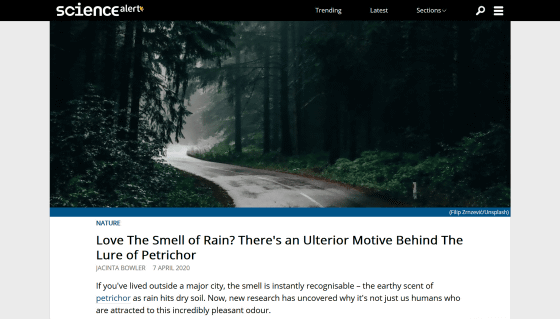It turns out that the causative substance of `` rain smell '' is used to change the behavior of creatures living in the forest

When it rains, it can feel a peculiar smell like moist soil, which is named '
Developmentally regulated volatiles geosmin and 2-methylisoborneol attract a soil arthropod to Streptomyces bacteria promoting spore dispersal | Nature Microbiology
https://www.nature.com/articles/s41564-020-0697-x
Love The Smell of Rain? There's an Ulterior Motive Behind The Lure of Petrichor
https://www.sciencealert.com/that-rain-smell-turns-out-we-re-smelling-the-circle-of-life

It is said that the smell of rain is composed of multiple chemical substances, and the smell of
However, it was not known why Streptomyces released organic compounds such as geosmin when they died, and the role that organic compounds released by microorganisms play in the forest soil environment. Therefore, international research team of Sweden and the United Kingdom of researchers, geosmin and microorganisms to release 2-methylisoborneol compounds, such as is, we are living in the soil of the forest Collembola so an experiment was conducted to examine the impact on the is. Collembola is a very common arthropod that has been identified in over 3000 species worldwide, and 360 species have been reported in Japan.
As a result of setting traps in the forest and examining the number of trapped beetles and examining the reaction to chemical substances in the laboratory, the beetles found colonies of Streptomyces coelicolor (Streptomyces coelicolor) , a kind of Streptomyces genus It was strongly attracted to the trap used, and it turned out that it was possible to detect geosmin and 2-methylisoborneol by touch. Collembola is a 'big fan' of geosmin and 2-methylisoborneol, and prefers to eat microorganisms that release these chemicals.

by
The research team believes that Streptomyces emits odorants to increase the likelihood that they will be eaten by colander, to 'extend their habitat.' Streptomyces, like filamentous fungi , has the property of producing spores and spreading new bacteria when ready to reproduce. Since the bacterium Streptomyces can not move around long distances by itself, it is necessary to rely on other creatures to spread spores.
This is where the colleagues feed on Streptomyces. If the stink bug eats Streptomyces or the spores attach to the surface of the body, the spores can move together with the colander, so if the Streptomyces is attracting the colander with chemicals such as geosmin. The research team is explaining.
It is also known that not only the beetles are sensitive to geosmin, but also humans are very sensitive to the smell of geosmin. Even if diluted to 1 billionth, it seems that humans can notice the smell of geosmin, but the reason why humans are sensitive to the smell of geosmin is not known at the time of article creation .

Related Posts:







